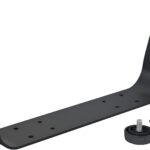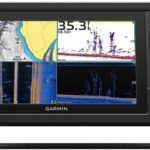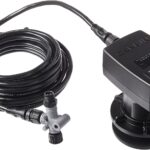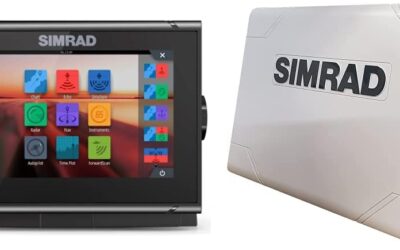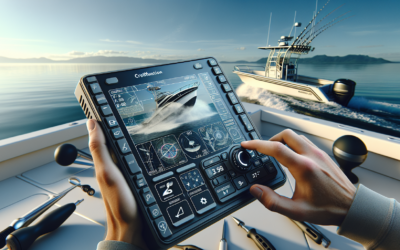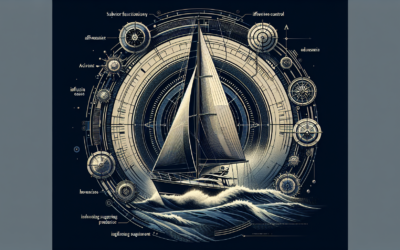In this article, you will explore the fascinating world of fish finders and gain a deeper understanding of their components. Get ready to uncover the mysteries behind transducers, screens, and other essential features that make up the anatomy of a fish finder. Whether you’re an avid angler or simply curious about the technology, this article will provide you with valuable insights and knowledge that will enhance your fishing experience. So, grab your fishing gear and let’s dive right into the incredible world of fish finders!
The Anatomy Of A Fish Finder: Understanding Transducers, Screens, And More
What is a Fish Finder?
A fish finder is an electronic device used by anglers to locate and catch fish underwater. It utilizes sonar technology to detect and display the presence of fish, underwater structures, and the depth of the water. Fish finders have become an essential tool for fishermen of all skill levels, as they provide valuable information to help improve fishing efficiency and success rates.
Importance of Understanding the Anatomy of a Fish Finder
To make the most out of a fish finder, it is crucial to understand its various components and how they work together. By familiarizing yourself with the anatomy of a fish finder, you will be able to choose the right features and functionalities that align with your fishing needs and preferences. Additionally, understanding each component allows you to utilize the fish finder to its full potential, making your fishing trips more productive and enjoyable.
Components of a Fish Finder
1. Transducers
Transducers are one of the most crucial components of a fish finder. They are responsible for transmitting and receiving sonar signals that bounce off objects underwater, providing information about the depth, structure, and location of fish. Understanding transducers is essential in optimizing the performance of your fish finder.
– Transducer Types
Fish finders come with different types of transducers, including transom mount, thru-hull, and portable transducers. Transom mount transducers are commonly used and easily mounted on the back of a boat. Thru-hull transducers are installed through a hole in the hull, providing more accurate readings. Portable transducers are convenient for fishing from different vessels or locations.
– Transducer Mounting Options
Choosing the right mounting option for your transducer depends on your boat’s hull type and personal preference. The transducer can be mounted inside the hull, on the transom, or thru-hull. Each mounting option has its advantages and considerations, such as signal clarity, ease of installation, and potential interference.
– Transducer Frequencies
Transducers operate at different frequencies, including high, medium, and low frequencies. Higher frequencies provide finer detail and are suitable for shallow waters, while lower frequencies penetrate deeper and are ideal for deep-sea fishing. Some fish finders offer multiple frequency options, allowing you to switch between settings based on your fishing environment.
2. Screens
The screen is the interface through which you view the information provided by the fish finder. Understanding the different types of display screens, resolution, color, and size is crucial in ensuring clear and detailed readings.
– Types of Display Screens
Fish finders can have either grayscale or color screens. Grayscale screens are generally more affordable and provide sufficient detail for most fishing situations. Color screens, on the other hand, offer enhanced clarity and better distinction between different fish and structures, making them suitable for professional anglers and avid fishermen.
– Screen Resolution and Color
Screen resolution refers to the number of pixels displayed on the screen. Higher resolution screens produce sharper and more detailed images. Additionally, choosing a fish finder with a color screen allows you to differentiate between different fish arches and underwater structures easily.
– Screen Size and Visibility
The size of the screen directly affects the visibility and readability of the displayed information. Larger screens offer a more extensive view and make it easier to analyze multiple data points simultaneously. However, it is essential to consider the available space on your boat and choose a screen size that does not obstruct your view or interfere with other equipment.
3. Interface and Controls
The interface and controls of a fish finder determine how user-friendly and intuitive it is to operate. Understanding the interface options, such as button controls or touchscreen, and the overall design is essential for a seamless fishing experience.
– Button Controls
Fish finders often have physical buttons for navigating menus, adjusting settings, and selecting options. Button controls are tactile and easy to operate, especially in rough and wet conditions. They provide quick access to essential functions without the need to navigate through touchscreen menus.
– Touchscreen Interface
Some fish finders feature touchscreen interfaces, offering a more intuitive and interactive user experience. Touchscreens allow for easy menu navigation and selection by simply tapping or swiping the screen. They often provide additional features like pinch-to-zoom for detailed analysis of the displayed information.
– User-Friendly Design
A user-friendly fish finder should have an intuitive menu layout and clearly labeled controls. The interface should be easy to navigate, even for beginners, and provide customizable settings to suit individual preferences. Additionally, consider features like backlighting for enhanced visibility in low-light conditions.
4. Power Source
The power source of a fish finder determines its portability and operational duration. Understanding the battery life, capacity, and power consumption is vital for uninterrupted fishing sessions.
– Battery Life and Capacity
Fish finders can be powered by either internal rechargeable batteries or external power sources. Internal batteries offer convenient portability, but their lifespan can vary depending on the model and usage. For longer fishing trips, consider selecting a fish finder with an extended battery life or carry additional batteries for backup.
– Power Consumption
Different fish finder models have varying power consumption rates. Higher-powered units with larger screens and advanced features tend to consume more battery power. Consider balancing your fish finder’s power consumption with your fishing needs to ensure you have enough energy to last throughout your trip.
5. Sonar Technology
Sonar technology is the heart of a fish finder, allowing it to detect and display underwater objects and fish. Understanding how sonar works, the cone angle, and imaging techniques will greatly enhance your fishing experience.
– Understanding Sonar
Sonar, short for sound navigation and ranging, uses sound waves to create images of underwater objects. A fish finder emits sound waves, which then bounce off objects and return to the transducer. By analyzing the time it takes for the waves to return, the fish finder can determine the depth, distance, and nature of the objects.
– Sonar Cone Angle
The sonar cone angle refers to the width of the sonar signal emitted by the transducer. Wide cone angles cover a larger area but provide less detailed information, making them suitable for searching large areas. Narrow cone angles provide a more focused beam, offering detailed information for precise fishing or structure identification.
– Sonar Imaging
Fish finders can display sonar images in various ways, including traditional 2D, down imaging, and side imaging. Traditional 2D sonar provides a basic representation of underwater objects and fish arches. Down imaging offers a detailed, almost photographic, view of the submerged environment directly beneath the transducer. Side imaging provides a wider coverage area, allowing anglers to view structures and fish located to the sides of the boat.
6. GPS Features
GPS features enhance the functionality of a fish finder by providing precise positioning, mapping, and navigation capabilities. Understanding the integrated GPS, mapping options, and waypoint functionalities can greatly assist in locating fishing spots and planning routes.
– Integrated GPS
Some fish finders come with integrated GPS receivers, allowing anglers to pinpoint their location accurately. The GPS system provides real-time information on speed, heading, and coordinates, enabling you to navigate and mark specific locations easily.
– Mapping and Navigation
Fish finders with mapping capabilities offer detailed charts and maps, providing important information about underwater topography, contours, and depths. These maps help you identify potential fishing spots, locate drop-offs, and navigate safely through unknown waters.
– Waypoints and Routes
Waypoints are specific locations marked on the GPS system that you can save for future reference. They allow you to mark successful fishing spots, underwater structures, or any other points of interest. Fish finders with route planning functionality enable you to create and follow predefined routes, streamline your fishing strategy, and save time on navigation.
7. Connectivity Options
Connectivity options enhance the versatility of a fish finder by allowing integration with other devices and software. Understanding wireless connectivity, network integration, and mobile apps can expand the capabilities of your fish finder.
– Wireless Connectivity
Wireless connectivity enables fish finders to communicate with other devices, such as smartphones, tablets, or external sensors. Bluetooth and Wi-Fi connections provide seamless data transfer and control, allowing you to monitor and control your fish finder remotely or access additional features through compatible mobile apps.
– Network Integration
Some fish finders can be integrated into a network system, allowing multiple devices to share and display information simultaneously. Network integration enables advanced functionalities like sharing sonar information between multiple displays, creating a cohesive and comprehensive view of the underwater environment.
– Mobile Apps and Software
Certain fish finders offer companion mobile apps and software that provide additional functionalities and features. These apps may include advanced mapping, weather updates, community-based fishing information sharing, and even social networking elements. Exploring and understanding the available apps and software can enhance your fish finding experience.
8. Installation and Maintenance
Proper installation and maintenance of your fish finder are crucial for optimal performance and longevity. Understanding installation considerations, maintenance requirements, and troubleshooting tips will ensure that your fish finder remains in excellent working condition.
– Installation Considerations
When installing your fish finder, consider factors such as proper transducer placement, wiring routes, and transom or hull mounting options. Follow the manufacturer’s instructions carefully and ensure all connections are secure. Proper installation will prevent signal interference, maximize performance, and protect the equipment from damage.
– Maintenance and Care
Regular maintenance is essential to keep your fish finder functioning at its best. Clean the screen, transducer, and other external components regularly to remove dirt, grime, and salt residue. Check and replace batteries as needed, and inspect the wiring connections for any signs of damage or corrosion. Regular maintenance will help extend the lifespan of your fish finder and ensure accurate and reliable readings.
– Troubleshooting Tips
In case of any issues or malfunctions with your fish finder, it is essential to have some troubleshooting knowledge. Refer to the user manual or manufacturer’s website for troubleshooting guides tailored to your specific model. Common troubleshooting tips include checking power connections, adjusting settings, and verifying transducer placement. If problems persist, consult customer support or seek professional assistance to resolve the issue promptly.
Understanding the anatomy of a fish finder, including its transducers, screens, interface, power source, sonar technology, GPS features, connectivity options, and installation and maintenance requirements, is crucial in maximizing its effectiveness and utility. By gaining knowledge of each component and how they work together, you can make informed decisions when selecting a fish finder and harness its full potential to enhance your fishing experience. Happy fishing!

